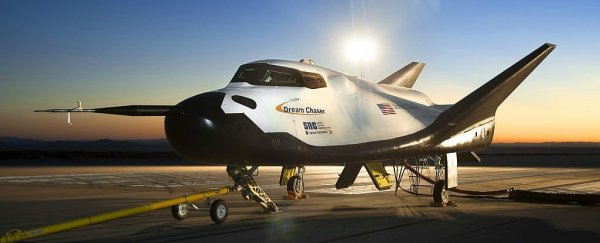NASA added a new member to its International Space Station (ISS) supply team that just dialed up the pressure on pre-existing members SpaceX and Orbital ATK.
On Thursday, the agency announced the awardees of its second round of Commercial Resupply services contracts - an agreement wherein NASA pays commercial spaceflight companies to ferry un-crewed cargo to, and sometimes from, the International Space Station.
NASA granted the first round of CRS contracts to aerospace juggernauts Orbital ATK and SpaceX in 2008, but this second round saw a new addition to the well-established team: the Sierra Nevada Corporation (SNC) Space Systems.
And right now, SNC has something that Orbital and SpaceX do not: a winged spacecraft that is designed to land on a runway - similar to NASA's Space Shuttles - after returning from a trip to space. In fact, some even call it a 'mini-Shuttle'.
The spacecraft is poetically called 'Dream Chaser'. It's about 30 feet (9.1 metres) long with a wingspan of nearly 23 feet (7.0 metres) across - about half the wingspan of a Learjet 45, which is a relatively small business aircraft. Moreover, Dream Chaser can reportedly survive 210 days in space, though it's not been tested, yet.
Dream Chaser has been the prized jewel of SNC since the company first unveiled its design plans in 2004. The advantage Dream Chaser brings to NASA's ISS supply team is that it can carry cargo from the ISS to a runway on land.
SpaceX's Dragon spacecraft can also ferry cargo back to Earth, but upon returning from space it parachutes into the ocean. And Orbital's Cygnus spacecraft is designed to burn up upon re-entry, meaning no returned supplies for those missions.
The reason it's so important for certain missions to return cargo to the land is so scientists can get their hands on their experiments as quickly as possible.
With a spacecraft like Dream Chaser, scientists will be able to get their data 3 to 6 hours after it has left space, which is critical for certain scientific experiments that assess the biological impacts of low-gravity in space, ISS Chief Scientist Julie Robinson said during the NASA announcement on Thursday.
"There are a lot of reasons to use animal studies to look at things like balance and sensory motor effects (of microgravity), and those are going to change so rapidly on return that we need to have the animals back right away," Robinson told Reuters.
So far, SNC has performed one flight test, which it completed in 2013. The flight itself, was reportedly flawless but upon touch down, the left landing gear failed to deploy. As a result, the spacecraft went skidding off the runway and eventually flipped over. Surprisingly, it only suffered minor damage.
SNC's corporate vice president Mark N. Sirangelo told NASA Spaceflight last October that the company is planning a second flight test sometime early this year.
NASA said its CRS2 contracts will cover un-crewed cargo missions starting in 2019 and running through to 2024. And as of right now, SNC will be reaping all of the missions that require this time-sensitive cargo returns.
The pressure is on for SpaceX, who could switch up the game. Although its Dragon spacecraft can only land via parachutes, SpaceX has publicly announced plans to develop another spacecraft, called Red Dragon, designed to touch down on land using rocket jets to slow it down upon descent. The idea is still in the design phase, right now.
This article was originally published by Business Insider.
More from Business Insider:
